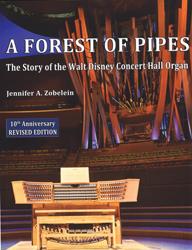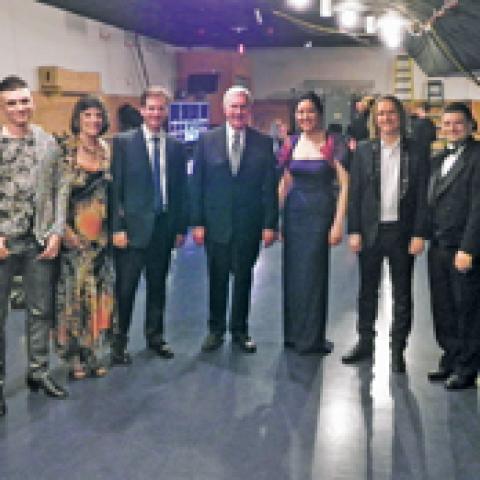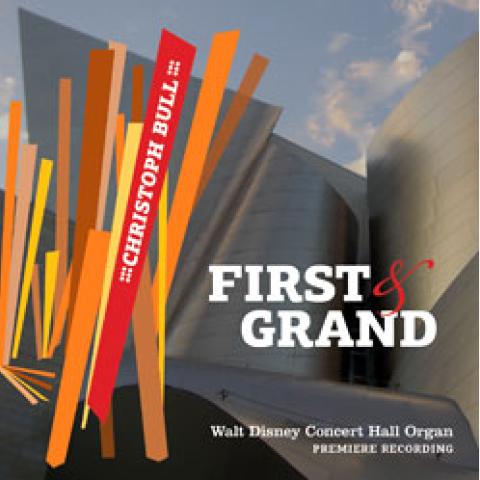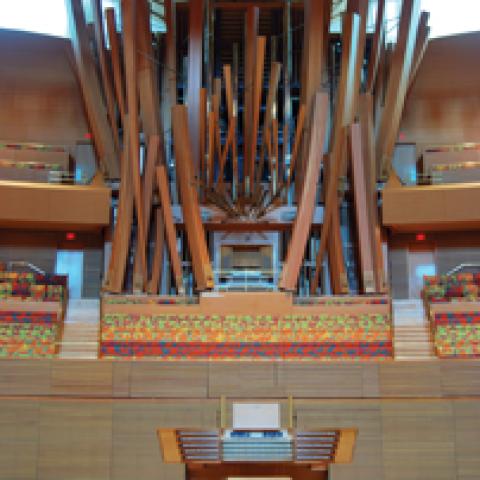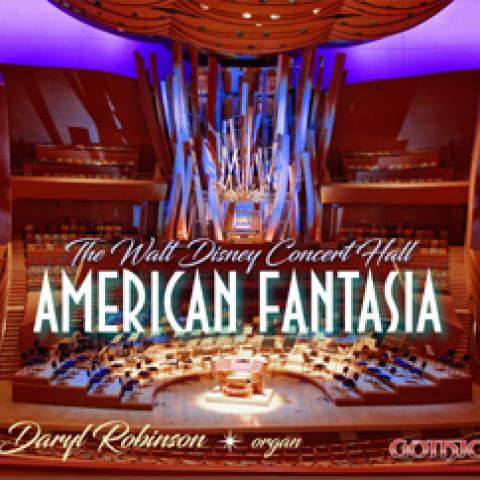LP in LA: The 47th National Convention of the American Guild of Organists July 4-9, 2004
More than 2000 organ enthusiasts spent an exhilarating week in the City of the Angels, enjoying a well-paced, well-organized schedule of high-quality musical events. Los Angeles weather, cool and sunny, was a joy after a month of unusually abundant rain in Texas.
In a sense, each person experienced a unique convention, since many of the morning programs were given two or three times in order to accommodate the number of attendees, and afternoon activities had been pre-selected from the more than 60 workshops and competition rounds offered. Evening events usually accommodated the entire convention, the exception being Tuesday's three concurrent services of worship. Perception and reception of particular events, thus, were influenced by the particular sequence in which they were experienced. For instance, Monday morning's "green group" progression of three recitals provided a satisfying order, while Wednesday's schedule did not.
Rather than a chronological, day by day report, here are some high points from "my" convention choices.
The Walt Disney Concert Hall and the first public performances on its Glatter-Götz/Rosales organ
Architect Frank Gehry's landmark building, new home of the Los Angeles Philharmonic Orchestra, is a striking and beautiful creation, immediately taking its place among America's most exciting concert halls. This 274 million dollar project pays apt tribute to American film maker Walt Disney with its decidedly whimsical and non-traditional architecture, and Gehry's organ case satisfies Lillian Disney's request that the organ not suggest a church. The controlled chaos of the pipe façade is the visual focus of the concert room; it is, however, well integrated into the hall, largely due to the use of the same wood, Douglas fir, for pipes, wall, and ceiling.
The 109-rank, four-manual organ is equipped with two consoles. In traditional case placement, the mechanical-action one was utilized for Joseph Adam's solo performances of Reger's Fantasia on BACH, Vierne's Naïades (played fleetly with impressionistic bravura), and Danse and Finale from Naji Hakim's Hommage à Igor Stravinsky. A movable, electric-action console, placed in front of the orchestra to the left of conductor Alexander Mickelthwate, allowed proper soloists' positions for organists Cherry Rhodes, in the program-opening premiere of James Hopkins' Concierto de Los Angeles, and Robert Parris, for the rarely-heard Concerto I in C Major of Leo Sowerby.
Architect Gehry was in attendance; so was the acoustician Yasuhisa Toyota, and the organ builders. A pre-concert stroll through Melinda Taylor's stunning gardens allowed an opportunity to view Gehry's rose-shaped fountain created from 8,000 hand-broken pieces of blue and white Delft china--his "Rose for Lilly," in honor of Mrs. Disney.
Solo Organ Performances
Mary Preston at the Glatter-Götz organ opus 2 (1998) in Claremont United Church of Christ
Dallas Symphony resident organist Mary Preston played a perfectly constructed program on a splendid mechanical-action organ in a church with sympathetic acoustical environment. At her third performance of the morning Ms. Preston elicited spontaneous (and forbidden) applause with a compelling opening work, Jean Guillou's dazzling, difficult, and complex Toccata; left us spellbound with the magical gossamer conclusion of Duruflé's Scherzo; showed both charm and considerable comedic ability in George Akerley's A Sweet for Mother Goose (six movements for organ and narrator based on familiar nursery rhymes); and displayed an absolutely magisterial rhythmic control in Jongen's Sonata eroïca. Program notes by Laurie Shulman pointed out a musical connection between Jongen and Messiaen, an analogy strengthened by the happily chirping birds heard through open windows on the right side of the church. Human auditors were equally ecstatic at this stellar performance.
Martin Jean at the Dobson organ in the Cathedral of Our Lady of the Angels
Yale University's Martin Jean gave a riveting performance of the complete Dupré Passion Symphony as conclusion to the second half of the first concert attended by the entire convention crowd. Spanish architect Rafael Moneo's massive cathedral, dedicated in 2002, seats 3,000 people in a spacious contemporary edifice of restrained elegance. The four-manual, 105-rank Dobson organ fills this space with noble and powerful sounds, as expected from its impressive 32-foot façade principals and dominating horizontal reeds. The organ performance was all the more appreciated coming as it did after a choral performance of works by Byron Adams, Morten Lauridsen, and C. Hubert H. Parry horribly amplified through the Cathedral's public address system. (Seated in the last row, we heard the choral sounds through crackling speakers positioned in the downward pointing, trumpet-shaped central posts of the chandeliers; any hope of a balance with the accompanying organ was thereby destroyed.)
Samuel Soria at the Cathedral of Our Lady of the Angels
Cathedral organist Samuel Soria played a prelude-recital before the Friday morning business meeting of the American Guild of Organists. Wanting to hear the Dobson organ from the best possible vantage point, we eschewed bus transport, walked the few blocks from the convention hotel to the cathedral, got there before the crowd, and chose an optimal seat in the left transept, diagonally across from the organ case. There the organ had splendid presence, character, and all the fullness one could want, qualities well illustrated in the playing of this talented young man. An appreciated tie-in to AGO history, his opening piece, Fanfare by past-president Alec Wyton, displayed the organ's horizontal reeds to fine advantage. Atmospheric impressionism was equally well served in Herbert Howells' Psalm Prelude, set 2, number 1 ("De profundis clamavi ad te, Domine") with its steady crescendo from the softest stop to a mighty full organ climax, and the corollary retreat to near silence. But it was in Sowerby's fiendishly difficult middle movement from his Symphony in G ("Fast and Sinister"--listed in the program as "Faster") that Soria best displayed his formidable technique and sense of the work's architecture, giving a sensitive, secure reading of this quintuple-meter tour de force.
Christopher Lane at the NYACOP Finals in St. James Episcopal Church
One of three finalists to compete in the National Young Artists Competition in Organ Performance, Lane, a student at the Eastman School of Music, gave the only playing of the required Roger-Ducasse Pastorale to realize both its delicacy and forward sweep. With no lack of virtuosity in the culminating mid-section "storm" music, Lane also limned the delicate contrapuntal writing in this unique organ work from the French composer. Judges Craig Cramer, Bruce Neswick, and Kathryn Pardee, deliberating at length, chose Yoon-Mi Lim (Bloomington) as first place winner. Dong-ill Shin (Boston) was the third contestant. Additional required repertoire played by all three contestants included Deux Danses (Le miroir de Meduse and Le Cercle des Bacchantes) by California composer James Hopkins, and Bach's Toccata, Adagio and Fugue in C, BWV 654, the only organ work by the master included in the published convention program book. (This final competition round was heard by approximately one-tenth of the convention registrants.) One additional Bach piece, a chorale prelude from the Orgelbüchlein, Herr Christ, der ein'ge Gottes Sohn, BWV 601, was played simply and stylistically by Namhee Han, a guest organist who gave the pre-concert recital before ensemble amarcord's program at Wilshire United Methodist Church. Ms. Han holds the Ph.D. in applied linguistics and is currently studying for her MM in organ at UCLA.
Paul Jacobs at Westwood United Methodist Church
Young Mr. Jacobs, playing from memory, had no technical or musical limitations during his noontime playing of the monumental Reger Chorale-Fantasy on Hallelujah, Gott zu loben. It was refreshing to hear Handel's G-minor Organ Concerto (opus 4, no. 1) as a representative (albeit in transcription) of the conspicuously absent baroque organ repertoire. Jacobs' attractive program also included John Weaver's Toccata and the premiere of Margaret Vardell Sandresky's The Mystery of Faith. With four manuals and 153 pipe ranks, the Schantz organ could have recused the added 85 digital voices to the advantage of the whole.
Lynne Davis at First Congregational Church
American organist Lynne Davis has spent much of her distinguished career in France. For her pre-service recital before Evensong she played three works from the French organ repertoire: Vierne's Toccata in B-flat minor, opus 53/6, Marchand's Grand Dialogue in C, and Franck's mighty Choral in E Major on the immense composite organs of First Congregational Church, comprising five manuals, 339 ranks, and seven digital voices for a truly "surround sound" experience. It was playing of intensity with a distinctly personal approach; especially in the Franck, Ms. Davis presented a nuanced, individual, and ultimately satisfying reading of this Romantic masterwork. In the Marchand, the organ certainly provided commanding reeds for a classic French Grand Jeu, but seemed to be lacking a Cromhorne of sufficiently aggressive character to assure a proper balance for the accompanying voices.
Choral Performances
ensemble amarcord at Wilshire United Methodist Church
The five-man vocal ensemble, all former members of the St. Thomas Choir of Leipzig, filled several unique categories at this convention: they were the only Europeans engaged for the program, and they gave the only ensemble presentation of a work by J. S. Bach, a two-stanza chorale from the Kreuzstab Cantata, BWV 56, "Du, o schönes Weltgebäude." It received an especially eloquent performance, with words perfectly articulated, and the almost-painfully beautiful suspensions viscerally calibrated for maximum tension and release of the piquant harmonies. The particularly welcome program alternated early music (stark and athletic organum, supple Byrd motets, the familiar Tallis anthem If Ye Love Me, elegant in its noble simplicity) with 20th (and 21st) century choral works. The concluding Gloria (2001) by Sidney Marquez Boquiren was performed with the singers in a circle. Long-held dissonant chords built around an ostinato pitch, were sustained throughout with nearly-unbelievable breath control. Repeated text phrases swirled like incense to create an unforgettable shimmer of sound. From start to finish this was virtuoso music making, with not a microphone or speaker to mar the sound.
Dale Adelmann's setting of the Spiritual "Steal Away to Jesus"
Heard as the Introit for the Service of Evensong at First Congregational Church, this, and the equally exquisite singing of Herbert Howells' St. Paul's Service by the choirs of All Saints' and St. James' Episcopal Churches, conducted by Adelmann and James Buonemani, proved to be the full ensemble choral highlights of the convention for this listener. Of course, choirs need to be superb at these services to compare with the hymn singing of a thousand, or more, organists, most of them paying attention to punctuation, pitch, and proper vocal production. It makes for participatory experiences that remain in the memory.
New Music
David Conte: Prelude and Fugue (In Memoriam Nadia Boulanger) for Organ Solo. E. C. Schirmer No. 6216.
What a way to begin the first solo organ recital of a convention! A single pedal B-flat sang out gently. Then a theme, beginning with the opening intervals of Raison's (and J. S. Bach's) Passacaglia was spun into a 14-measure cantilena, after which the solemn five-minute Prelude built slowly, always above the continuing pedal point. The ensuing Fugue, its memorable subject carefully shaped by Ken Cowan at the recent Fisk organ in Bridges Hall of Music at Pomona College, fulfilled the promise of the Prelude, moving inexorably from duple to triple accompanimental figurations, and building to a full climax with pedal flourishes. A work worthy of Maurice Duruflé or Gabriel Fauré, and a fitting tribute, as well, to Boulanger, the great French teacher with whom Conte studied for three years early in his career.
George Akerley: A Sweet for Mother Goose for Organ and Narrator. Hinshaw Music, Inc. HPO3009
Winner of the 2004 Holtkamp-AGO award in organ composition, this charmer of a suite weds appropriately pictorial music with rhythmically notated texts for the narrator in a pleasure giving work that should find its way into many organ recital programs. (It is music for young persons of all ages.) "Little Bo-Peep" allows the organist to take off on an extended pedal cadenza, to be halted only by the irritated shout of the narrator. The head of a school instructs her charges on good behavior in "The Clock." There's Irish musical color aplenty in "The Cats of Kilkenny," and, after a recitation of the poetry, the organist plays a solo tone poem to illustrate the "Tale of Miss Muffet." Mathematical note groupings provide comment for "One, Two, Buckle My Shoe;" while the concluding movement ("The Fiddlers") provides chuckles of recognition with its ritornello based on the famous Widor Toccata. That it was so well presented by Mary Preston, with the ebullient Kathy Freeman as narrator, made for a memorable premiere indeed.
Denis Bédard: Duet Suite for Organ and Piano (Details: www.majoya.com)
Duo Majoya (Marnie Giesbrecht, organ; Joachim Segger, piano) gave a most unusual recital at Bel-Air Presbyterian Church. Two Canadian composers provided commissioned works for the Duo; each had some interesting musical ideas to communicate. The more accessible work was this Suite, comprising an Introduction, Fughetta, Menuetto, Romance, and Final, full of wit, good humor, and memorable melodies, many reminiscent of Poulenc's catchy and romantic voice. Three movements from Jeffrey McCune's Crossing to Byzantium, and his arrangement of Stravinsky's Danse infernale de roi Katschei from The Firebird, plus Joe Utterback's brief Images: A Jazz Set completed the program, which would have benefited from more textural variety, perhaps provided by a solo offering from each of these fine players. The Bel-Air organ, reconstituted from a Casavant instrument heavily damaged in the 1994 Northridge earthquake, now consists of 60 pipe ranks plus 91 digital voices, including both Cherubim and Seraphim hanging speakers: not a particularly happy marriage of sounds for this hilltop-sited church.
Other newly-commissioned and prize-winning works heard at convention events I attended included anthems by Byron Adams and Michael Bedford, works for instruments with organ by Mary Beth Bennett, Ian Krouse, and Erica Muhl, plus the Hopkins and Sandresky works mentioned previously, as well as an anthem by Williametta Spencer, premiered in the Ecumenical Protestant service, not on my schedule.
Workshops
Organ Recordings from the Past, David McVey's self-effacing session on gems from the audio history of organ playing, was a model of effective, well thought-out presentation. All the requisite citations were listed in a spacious 8-page handout. The motto "Res ipsa locutor [The thing speaks for itself]" was borne out as McVey kept comment to a minimum in order to allow complete performances of works recorded by Widor (Andante sostenuto from his Gothic Symphony, committed to disc in 1932), Tournemire (Chorale-Improvisation on "Victimae paschali," 1930), Thalben-Ball (Wagner's Ride of the Valkyries, 1931), Sowerby (his Carillon, 1946), Schreiner (Vierne's Naïades, 1959), Biggs (Daquin's Noël grand jeu et duo at the 1936 Aeolian-Skinner organ of the Germanic Museum at Harvard), Fox (Bach's Passacaglia at Avery Fisher Hall, Lincoln Center, 1963), and Crozier (Dupré's Prelude and Fugue in G minor, opus 7/3, 1959).
Panel Discussion on the Disney Hall Organ, ably moderated by Jonathan Ambrosino, with organ builders Caspar von Glatter-Götz and Manuel Rosales, architect Craig Webb from Gehry Partners, and organ consultant Michael Barone.
An overflow crowd of 500 assembled to hear the whys and wherefores behind the inspiration and evolution of Gehry's unusual organ design for the new hall, and the challenges posed during the installation of the instrument.
Extra-musical happenings
Television personality and actor David Hyde Pierce (of Frasier fame) brought along the necessary props: his organ shoes, a book of registrations copied down at some early lessons (numbers only, no stop names), a tattered copy of the Gleason Method. Pierce, who really did study organ with several noted teachers, took his audience through a quick course on ornamentation ("I don't care"), temperament, and various other organ-specific arcana. The huge crowd responded with almost-constant hilarity.
The Very Rev. Canon Mary June Nestler's sermon at Evensong moved with quiet humor from her own experiences as a voice student through some of the shared vicissitudes of the organist's profession (especially vis-à-vis relationships with the clergy) to a sound theological conclusion, and a prayer for peace.
Class Acts
Frederick Swann: organist and AGO president extraordinaire
Both for a very fine recital at the Crystal Cathedral, his "home base" during the years 1982-1998, and for his deft, unpretentious handling of the American Guild of Organists presidency, Swann deserves high accolades. Always in command of the music he played, never pompous or overbearing in his official actions, Fred serves as an exemplary leader for the national organization, and he represents the profession well with his high musical and personal standards. Who would not love him for his one-sentence disposal of the listed "Presidential Remarks" at the national meeting? Kudos, as well, for his service as performances chair of the convention. The artists selected for the program were consistently top-notch.
The Convention Committee
To Dr. Robert Tall and his legions of hardy workers for the stellar planning and smooth organization of a first-rate convention, especially noted in the efficient and on time management of the necessary bus transportation. Mailing the convention program book (itself a work of art) more than a month before the actual event allowed attendees the opportunity for advance preparation and orientation. Bravi tutti!
Additional Observations
It was my first experience to see two hotel elevators (in the headquarters hotel, the Westin Bonaventure) marked with historic plaques, noting their use by actor (now Governor) Arnold Schwarzenegger in the 1993 movie The Terminator.
Crystal Cathedral organist Christopher Pardini's fine performances of The Joy of the Redeemed, composed by AGO founding member Clarence Dickinson, not only showcased the Aeolian-Skinner organ in the Cathedral's Arboretum, but served as an effective aural connection to an important figure in the Guild's history.
What a savvy idea to present this year's AGO President's Award to Craig Whitney, an assistant managing editor at The New York Times and author of the best selling book All the Stops. His enthusiastic and engaging writing about the world of organ music and its personalities has provided some much needed popular awareness for the profession.
Peter Krasinski's masterful organ improvisation at the AGO annual meeting was based on the song "Chicago, Chicago," a theme selected and presented to him by improvisation committee chair Ann Labounsky. This served as a not-so-subliminal aural advertisement for the next national convention, to be held July 2-6, 2006.
